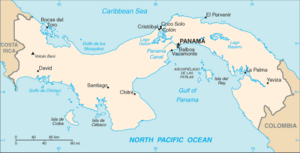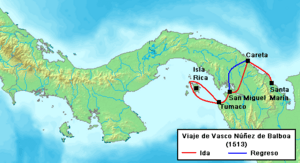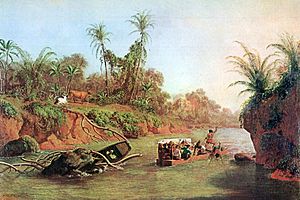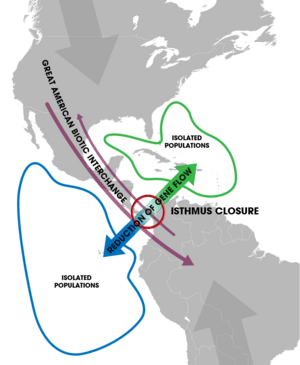Isthmus of Panama facts for kids
The Isthmus of Panama is a thin strip of land. It connects North America and South America. This important land bridge sits between the Caribbean Sea (part of the Atlantic Ocean) and the Pacific Ocean. The country of Panama and the famous Panama Canal are located here.
This narrow piece of land is very important. It helps ships travel between oceans. It also allows animals and plants to move between continents. Scientists believe the Isthmus of Panama formed about 2.8 million years ago. This event changed ocean currents, like creating the Gulf Stream. It also had a big impact on life on Earth.
History of the Isthmus
The Isthmus of Panama has a long and exciting history. In 1513, a Spanish explorer named Vasco Núñez de Balboa heard about a "South Sea" from local people. He then traveled across the isthmus. On September 25, 1513, he became the first European to see the Pacific Ocean.
Later, in 1519, the town of Panamá was started. It grew into a very important trading port. This was especially true after gold and silver were found in Peru. In 1671, a Welsh privateer named Henry Morgan attacked the city. A privateer was like a pirate, but they had permission from their government to attack enemy ships. Morgan destroyed the city of Panama. The town was then rebuilt a few kilometers away. The old ruins, called Panamá Viejo, are now a World Heritage Site.
For many years, valuable silver and gold from Peru were carried across the isthmus. They went from the Pacific side to the Caribbean side. From there, Spanish ships took the treasures to Spain.
The California Gold Rush began in 1849. This brought many people who wanted to get rich. They traveled from the eastern United States to California. They would sail to Panama, cross the isthmus by foot or horse, and then take another ship to San Francisco. This made the Isthmus of Panama a very busy travel route.
Later, a French engineer named Ferdinand de Lesseps tried to build a canal across Panama. He had built the Suez Canal. But his company went bankrupt in 1889. In 1902, the United States decided to finish the canal. They helped Panama become independent from Colombia. The Panama Canal was finally finished in 1914. It changed global shipping forever.
How the Isthmus Formed
Millions of years ago, North and South America were not connected. A large ocean channel, called the Central American Seaway, separated them. The waters of the Pacific and Atlantic Oceans mixed freely.
Deep under the ocean, two huge pieces of the Earth's crust, called tectonic plates, were slowly moving. The Cocos Plate was sliding under the Caribbean Plate. This movement created a lot of pressure and heat. This led to underwater volcanoes forming. Some of these volcanoes grew so large they became islands.
Over time, huge amounts of sand and dirt from North and South America filled the spaces between these new islands. Over millions of years, these deposits built up. Eventually, the gap was completely filled. By about 4.5 million years ago, the Isthmus of Panama had fully formed. It created a land bridge between the two continents. Some scientists even think it might have formed earlier, around 10 million years ago.
The formation of this land bridge had a big effect on Earth's climate. It changed ocean currents, like the Gulf Stream. This warm current now flows towards northern Europe. This warm, moist air led to more snow and ice. It helped create the large Arctic ice cap and contributed to the ice age we are in now.
Animals and Plants of the Isthmus
The Isthmus of Panama is like a natural highway for animals and plants. Because it connects two huge land masses, it has a mix of species from both North and South America. This event is called the Great American Interchange.
For example, animals like the opossum, armadillo, and porcupine originally came from South America. They crossed the land bridge to reach North America. In the same way, animals like bears, cats, dogs, horses, llamas, and raccoons traveled south across the isthmus.
The tropical climate of Panama is perfect for many colorful species. You can find over 978 different kinds of birds here! There are also many insects, amphibians, fish, and reptiles. The weather is usually wet on the Caribbean side of the isthmus. But on the Pacific side, there are clear wet and dry seasons.
See also
 In Spanish: Istmo de Panamá para niños
In Spanish: Istmo de Panamá para niños





